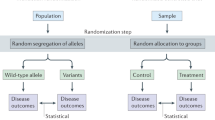Summary
Confounding is a basic problem of comparability-and therefore has always been present in science. Originally a plain English word, it acquired more specific meanings in epidemiologic thinking about experimental and non-experimental research. The use of the word can be traced to Fisher. The concept was developed more fully in social science research, among others by Kish. Landmark developments in epidemiology in the second half of the 20th century were by Cornfield and by Miettinen. These developments emphasised that reasoning about confounding is almost entirely an a priori process that we have to impose upon the data and the data-analysis to arrive at a meaningful interpretation. The problems of confounding present their old challenges again in recent applications to genetic epidemiology.
Zusammenfassung
Confounding ist ein grundlegendes Problem der Vergleichbarkeit und somit schon immer Teil der Wissenschaft. Ursprünglich ein einfaches englisches Wort, hat es in der experimentellen und nicht experimentellen epidemiologischen Forschung spezifischere Bedeutungen angenommen. Der Gebrauch des Wortes geht auf Fischer zurück. Das Konzept wurde in den Sozialwissenschaften unter anderen von Kish noch umfassender entwickelt. Historische Entwicklungen in der Epidemiologie der zweiten Hälfte des 20. Jahrhunderts sind auf Cornfield und Miettinen zurückzuführen. Diese Entwicklungen verdeutlichten, dass die Argumentation mit Störfaktoren/Confounding ein fast ausschliesslich deduktiver Prozess ist, den wir für die Daten und Datenanalyse anwenden müssen, um zu einer aussagekräftigen Interpretation zu gelangen. Die Probleme des Confounding sind auch in der neueren Anwendung auf dem Gebiet der genetischen Epidemiologie dieselben geblieben.
Résumé
L'effet de confusion est un problème élémentaire de comparabilité et a donc toujours été présent en science. C'était à l'origine un simple mot d'anglais, mais il a acquis une signification spécifique dans la pensée épidémiologique par rapport à la recherche expérimentale et non expérimentale. L'utilisation du mot remonte à Fisher. Le concept a été approfondi dans la recherche en science sociale, entre autres par Kish. Le développement du concept en épidémiologie dans la deuxième moitié du 20ème siècle a été assuré par Cornfield et Miettinen. Ces développements ont mis l'accent sur le fait que le raisonnement sur l'effet de confusion est presque entièrement un processus a priori que nous devons imposer aux données et à l'analyse afin d'aboutir à une interprétation qui ait du sens. Les vieux défis liés à l'effet de confusion se représentent dans leurs applications récentes en épidémiologie génétique.
Similar content being viewed by others
References
Altman DG, Bland JM (1999). Treatment allocation in controlled trials: why randomise? BMJ318:1209.
Bernard CI (1966). Introduction à l étude de la médecine expérimentale. Reprint of 1865 ed. Paris: Flammarion.
Blalock HM (1964). Causal inference in nonexperimental research. Chapel Hill. University of North Carolina Press.
Campbell DT, Stanley JS (1963). Experimental and quasi-experimental designs for research on teaching. In: Gage NL, ed. Handbook of research on teaching. Chicago: R. McNally:171–246.
Chalmers I (1999). Why transition from alternation to randomisation in clinical trials was made. BMJ319:1372.
Cornfield J, Haenszel W, Hammond EC, Lilienfeld AM, Shimkin MB, Wynder EL (1959). Smoking and lung cancer: recent evidence and a discussion of some questions. J Natl Cancer Inst22:173–203.
Cornfield J (1971). Recent methodological contributions to clinical trials. Am J Epidemiol104:408–21.
Cornfield J (1971). The University Group Diabetes Program: a further statistical analysis of the mortality findings. JAMA217:1676–87.
Fisher RA (1937). The design of experiments. London: Oliver and Boyd.
Greenland S, ed. (1987). Evolution of epidemiologic ideas: annotated readings on concepts and methods. Chestnut Hill, MA: Epidemiology Resources.
Hardy RC, White C (1971). Matching in retrospective studies. Am J Epidemiol93:75–6.
Hill AB (1965). The environment and disease: association or causation? Proc Royal Soc Med58:295–300.
Ibrahim MA, ed. (1979) Proceedings of symposium on the case-control study. J Chron Dis32:1–139.
Katsuya T, Koike G, Yee TW, et al. (1995). Association of angiotensin gene T235 variant with increased risk of coronary heart disease. Lancet345:1600–3.
Kish L (1959). Some statistical problems in research design. Am Sociol Rev26:328–38.
Lilienfeld AM (1982). Ceteris paribus: the evolution of the clinical trial. Bull Hist Med56:1–18.
MacMahon B, Pugh TF (1970). Epidemiology, principles and methods. Boston: Little, Brown and Co.
Mantel N, Haenzel W (1959). Statistical aspects of the analysis of data from retrospective studies of disease. J Natl Cancer Inst22:719–48.
Miettinen OS (1970). Matching and design efficiency in retrospective studies. Am J Epidemiol91:111–8.
Miettinen OS (1976). Stratification by a multivariate confounder score. Am J Epidemiol104:609–20.
Miettinen OS, Cook EF (1981). Confounding, essence and detection. Am J Epidemiol114:593–603.
Rothman KJ (1986). Modern epidemiology. Boston: Little, Brown and Co.
Rothman KJ, Greenland S (1998). Modern epidemiology. 2nd ed. Philadelphia: Lippincott-Raven.
Sackett DL, Richardson WS, Rosenberg W, Haynes RD (1997). Evidence-based medicine: how to practice and teach EBM. New York: Churchill Livingstone:148–9.
Susser M (1973). Causal thinking in the health sciences: concepts and strategies of epidemiology. New York: Oxford University Press.
Taubes G (1995). Epidemiology faces its limits. Science269:164–9.
Urbach P (1993). The value of randomization and control in clinical trials. Stat Med12:1421–31.
Vandenbroucke JP (2001). In defense of case reports and case series. Ann Intern Med.134:330–4.
Vandenbroucke JP, de Craen AJ (2001). Alternative medicine: a “mirror image” for scientific reasoning in conventional medicine. Ann Intern Med135:507–13.
Wacholder S, Rothman N, Caporaso N (2000). Population stratification in epidemiologic studies of common genetic variants and cancer: quantification of bias. J Natl Cancer Inst92:1151–8.
Wold H (1956). Causal inference from observational data. J Royal Stat Soc (A)119:28–61.
Wynder EL (1996). Invited commentary: response toScience article “Epidemiology faces its limits”. Am J Epidemiol143:747–9.
Author information
Authors and Affiliations
Corresponding author
Rights and permissions
About this article
Cite this article
Vandenbroucke, J.P. The history of confounding. Soz Präventivmed 47, 216–224 (2002). https://doi.org/10.1007/BF01326402
Issue Date:
DOI: https://doi.org/10.1007/BF01326402




